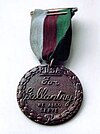|

|
The Dickin Medal was instituted in 1943 in the United Kingdom by Maria Dickin to honour the work of animals in war. It is a bronze medallion, bearing the words "For Gallantry" and "We Also Serve" within a laurel wreath, carried on ribbon of striped green, dark brown and pale blue. It is awarded to animals that have displayed "conspicuous gallantry or devotion to duty while serving or associated with any branch of the Armed Forces or Civil Defence Units". The award is commonly referred to as "the animals' Victoria Cross"
The first recipients of the award, in December 1943, were three pigeons, serving with the Royal Air Force, all of whom contributed to the recovery of air crew from ditched aircraft during the Second World War. The most recent animal to be honoured is Treo, a black Labrador, honoured for his "heroic actions as an arms and explosives search dog in Afghanistan". As of March 2010, the Dickin Medal has been awarded 63 times. (more...)
|